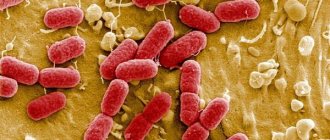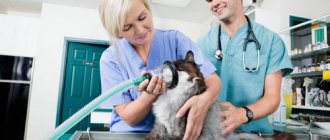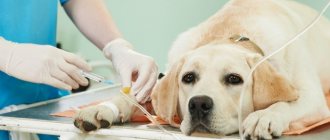This inflammatory process is considered a serious disease and often leads to thrombosis, as well as sepsis (blood poisoning). The difference from other similar diseases is that phlegmon in dogs does not contain precise signs. The disease is formed in most cases due to the entry of purulent bacteria into the matter.
How can you catch cellulitis?
In exceptional cases, a specific chemical influence can cause the disease. However, inflammation does not always occur for these reasons. For example, when you walk your dog, it may accidentally injure itself or get into fights with other dogs.
As a result of the injuries received, a large number of pyogenic microflora, for example, Staphylococcus aureus, can enter the affected area. Much attention should be paid to small wounds; you should not think that they will heal on their own. After all, a seemingly small bite often leads to serious consequences.
Every owner will be interested in the question, why do these complications occur? In the area of a small bite, a sufficient cavity is formed, where suitable conditions are formed for the occurrence of inflammatory processes. Therefore, if you notice in time that your dog has a wound, it is better to immediately contact a veterinarian to provide qualified assistance. Every dog owner should know that properly provided assistance can prevent the appearance and development of phlegmon.
Symptoms of the disease
At the first stage of development, severe swelling forms. Touching this area activates very severe pain in the dog. As the disease progresses, dogs become less active. In addition, breathing and heart rate noticeably accelerate. As a result of the disease, a complete or slight decrease in appetite can be observed. At the most late stages of formation, tissue necrosis can be observed.
During the development of the disease, complete intoxication occurs, since the number of neutrophils in the blood increases, which indicate an increase and change in the cellular composition of the blood. It will not be possible to establish a clear diagnosis of the disease in everyday circumstances, since a puncture is required, which means that the help of a veterinarian is mandatory.
Let's look at the main symptoms of phlegmon in a dog, and if they appear, you should immediately contact the clinic:
- Hot and reddened bulge in the subcutaneous tissue.
- Decreased appetite.
- Apathetic state.
- Reluctance to move, jump.
- Every movement causes suffering.
- Rapid increase in body temperature.
Be sure to tell the veterinarian about the animal’s behavior and condition so that he can make an accurate diagnosis. During the examination, the doctor must establish the presence of suppuration. You also cannot do without blood tests to detect the total number of leukocytes. When there is a possibility of a hostile neoplasm (sarcoma), a biopsy with further examination of the painful material is needed.
Treatment of the disease
It is possible to cure a pet from phlegmon only in the early stages of the disease.
If the disease is at stages 1-3 of development, it is necessary to use warm compresses , mostly alcohol. In the area of edema, the affected tissue is cleansed. After these procedures, the area of inflammation is lubricated with ichthyol. In addition, the dog is prescribed antibiotics such as penicillin or streptomycin, administered intramuscularly. If the phlegnoma area has grown greatly, small incisions (about 1-1.5 cm in length) are made to remove fluid and reduce pressure inside the tissues, arranged in a checkerboard pattern with a distance of 2-3 cm between them. The area with notches is covered with a bandage with furatsilin and ethacridine moistened with a hypertonic solution of medium salts.
It is important to know that complete peace and quiet plays an important role in a pet’s recovery.
If phlegmon has developed to late stages, surgical opening of the affected area . Surgical intervention will reveal all malignant formations and allow the infiltrate to leave the body. The operation is performed under complete anesthesia or immobilization of the animal. In such cases, large incisions are made to ensure free flow of fluids from the tissues. Subsequently, the wound is powdered with a variety of powder-type antiseptics, and in some cases, a synthomycin emulsion and liniment applications are used. Also in the later stages, calcium chloride and antibiotics are prescribed.
To eliminate possible intoxication, the dog is prescribed intravenous glucose, and pyrogenal is used to accelerate the healing of the formed, resorption of scar tissue and the further formation of elastic scars.
No matter what stage of phlegmon your pet is at, it is under no circumstances recommended to treat it with your own methods. It is best to take your dog for treatment.
Causes of appearance and preventive measures
The cause is considered to be anaerobic and putrefactive microflora and the penetration of pathogenic microorganisms into the scratch. The causative agents are usually considered to be streptococci and staphylococci. The spread of inflammation directly depends on the decrease in immunity initiated by exhaustion, prolonged illness, and intoxication.
The most severe forms of the disease appear under the influence of abundant anaerobes that multiply without oxygen. There are anaerobic, purulent and putrefactive phlegmon. Anaerobic manifestations are characterized by serous inflammation and necrosis of soft tissues, and the formation of blisters.
Putrefactive phlegmon in a dog involves necrosis of numerous areas of tissue, melting of tissue, abundant accumulation of pus and a foul odor. Also, inflammation can progress against the background of the subsequent spread of some primary purulent process, for example, with advanced forms or improperly treated abscesses, boils, carbuncles.
As preventive measures, it is recommended to carry out several medical measures: compliance with the rules of disinfection and prevention of wound suppuration;
- timely processing;
- prevention of microtraumas;
- timely treatment of local sources of infection.
Diagnostic methods
As a rule, to diagnose phlegmon, the doctor prescribes:
- general and biochemical blood tests;
- general and biochemical urine tests;
- X-ray of the affected area;
- Ultrasound examination of inflamed tissues.
If necessary, other studies can be conducted to clarify the patient's condition.
How to properly treat cellulitis in dogs
In the development of phlegmon, there are a number of stages for which proper treatment methods have been invented. Treatment of phlegmon in a dog is based on stopping the inflammatory process and cleansing the source of damage.
- Stage 1 - swelling with inflammation forms.
- Stage 2 - a cellular barrier is created.
- Stage 3 - accumulation of pus limited by the capsule occurs, necrosis progresses.
- Stage 4 - the formation of abscesses ends, inflammation has formed.
- Stage 5 is the stage of the complex granulation process.
- Stage 6 - scar formation occurs.
At stages I–III, novocaine blockades are performed for treatment, and medications with novocaine are injected. At stages II–V, substances are determined to strengthen and normalize the functioning of the heart. At stages II–III, when the area is severely swollen, skin incisions are made to remove exudate. The incisions are covered with alcohol lotions with furatsilin solution. At stage IV, dead tissue is removed. The procedure is performed under general anesthesia or using sedatives and novocaine anesthesia. Large incisions are made to allow the fluid to escape. The wound is powdered with disinfecting powders, and applications of balsamic liniment (Vishnevsky ointment) are applied.
When scars form, it is effective to use an immunomodulator of bacterial origin to resolve them.
When there are doubts regarding the presence of a purulent inflammatory process, it is necessary to visit a veterinarian, because suppuration is dangerous due to the maturation of a septic condition and surgical intervention will be necessary for cure. Medical blood parameters should be assessed and systemic antibacterial medications should be prescribed.
Peculiarities
Cellulitis is divided into primary and secondary types. In the case of primary ones, the cause of the disease is open or closed injuries. The occurrence of secondary phlegmon can be provoked by carbuncles, boils, purulent arthritis, abscesses and other types of purulent inflammation.
Depending on the epicenter of spread, this disease occurs:
- Subfascial.
- Parachondral.
- Subcutaneous.
- Intermuscular.
- Slimy.
According to the type of fluids formed from the tissues or cavity of the dog, they are classified into the following groups:
- Purulent or purulent-hemorrhagic.
- Chemical (gas).
- Serous.
- Putrid.
The course of phlegmon can be divided into the following six stages:
- At an early stage of the disease, the dog begins to develop inflammatory swelling on the body.
- The formation of a cellular barrier begins.
- The formation of necrotic formation and the start of the abscess formation process.
- The final maturation of the disease, in which necrotic processes are finally formed.
- Beginning of granulation.
- The scarring stage begins.
Should I self-medicate?
And self-medication can cause a dangerous condition. When the process of inflammation occurs in an acute form and rapidly spreads to the surrounding tissue, such a phlegmon is called diffuse.
In case of diffuse phlegmon, the animal should be provided with timely medical assistance. Otherwise, extensive necrosis of the skin and underlying tissues, blood poisoning and death of the animal can occur. If signs of intoxication increase and there is a lack of positive results, urgent surgical intervention is indicated.
A sick animal is released from work, placed in a clean room, and poultices and warming compresses are used during the first 1-3 days. Prevention of phlegmon consists of preventing injuries and providing timely first aid.
Currently reading:
- Thyroid dysfunction in dogs (hypothyroidism)
- What to do if your dog has an abnormal bite
- What do tumors on a dog's body and tail mean?
- Seven Signs and Remedies for Getting Rid of Fleas in Dogs
Disease prevention
To prevent the development of a dangerous disease, the following preventive measures must be observed:
- Try to protect the dog from traumatic injuries to the skin.
- Treat wounds and scratches on the animal's skin with antiseptic solutions to prevent infection.
- In cases where skin lesions do not heal for a long time, seek professional help.
All skin diseases must be treated promptly.
It is important to realize that phlegmon can be cured only at the initial stage, and if the slightest problem appears with the condition of the animal’s skin, visit a veterinary clinic.









